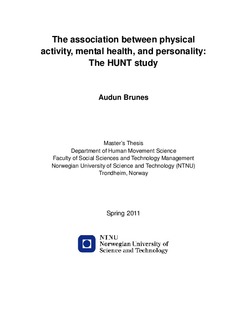| dc.contributor.advisor | Augestad, Liv Berit | nb_NO |
| dc.contributor.advisor | Gudmundsdottir, Sigridur Lara | nb_NO |
| dc.contributor.author | Brunes, Audun | nb_NO |
| dc.date.accessioned | 2014-12-19T14:44:28Z | |
| dc.date.available | 2014-12-19T14:44:28Z | |
| dc.date.created | 2011-10-11 | nb_NO |
| dc.date.issued | 2011 | nb_NO |
| dc.identifier | 447308 | nb_NO |
| dc.identifier.uri | http://hdl.handle.net/11250/271522 | |
| dc.description.abstract | Background: Previous studies have suggested that physically active behavior is associated with reduced symptoms of depression and anxiety. It is uncertain whether this relationship is affected by a third underlying factor. The aim of this study is to evaluate the association between physical activity (PA), symptoms of depression and anxiety, and personality traits.
Methods: During the period 2006–2008, the third phase of a population-based health survey (HUNT 3) was conducted in the county of Nord-Trøndelag in Norway. In total, 38,743 subjects aged 19 years or older completed the self-reported questionnaires on PA, mental health problems and personality in HUNT 3, of which 21,722 (56.1%) were women and 17,021 men (43.9%). The Hospital Anxiety and Depression Scale (HADS) was used to detect case-level symptoms of depression and anxiety, while the Eysenck Personality Questionnaire (EPQ) was used to measure the stable and consistent personality dimensions extroversion and neuroticism. Analysis focused on the odds of HADS-defined depression and anxiety comparing different levels of PA. Also, the linear trend between PA and personality scores was assessed.
Results: The prevalence of depression and anxiety scores above 8 was 9.5% and 14.1% respectively. Distribution of HADS-defined anxiety, scored extroversion, and scored neuroticism was higher among women compared with men, while HADS-defined depression had a higher distribution among men. The results from this cross-sectional study suggest that moderately physically active individuals have significantly lower odds of symptoms of depression and anxiety compared with less physically active individuals (p < 0.05). High PA had no further effect on mental health. A lower risk of HADS-defined anxiety was found among physically active women in comparison with physically active men. In the association with personality, lower levels of PA had a significant negative linear trend than high PA in relation to extroversion score (p < 0.01) and a significant positive linear trend with lower PA than high PA in relation to neuroticism score (p < 0.01). Small and consistent effects of the association between PA and scored extroversion and neuroticism were observed among both women and men.
Conclusion: Subjects reporting regular PA were less likely to report symptoms of depression, but only physically active women were associated with lower symptoms of anxiety. Personality may be an important underlying factor in explaining this association, but other possible mechanisms might be more elucidating. | nb_NO |
| dc.language | eng | nb_NO |
| dc.publisher | Norges teknisk-naturvitenskapelige universitet, Fakultet for samfunnsvitenskap og teknologiledelse, Institutt for bevegelsesvitenskap | nb_NO |
| dc.subject | Social and Behavioural Science, Law | en_GB |
| dc.title | The association between physical activity, mental health, and personality: The HUNT study | nb_NO |
| dc.type | Master thesis | nb_NO |
| dc.source.pagenumber | 35 | nb_NO |
| dc.contributor.department | Norges teknisk-naturvitenskapelige universitet, Fakultet for samfunnsvitenskap og teknologiledelse, Institutt for bevegelsesvitenskap | nb_NO |
